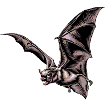Museum, University of Nebraska State

University of Nebraska State Museum: Mammalogy Papers
Document Type
Article
Date of this Version
2010
Citation
Journal of Zoology (2010) 282: 284–290.
doi: 10.1111/j.1469-7998.2010.00741.x
Abstract
Bite forces of 39 species from six families of New World bats with a variety of diets are quantified with a force meter under field conditions. Using regression approaches we search for a model that is a good morphological predictor of these bite forces. Body mass, an index that ignores differences in skull morphology, has a statistically significant relationship with bite force (R2 = 0.76) but is a relatively poor predictor compared with our best model (R2 = 0.94). The two best models of the eight we examine are one based on an estimate of strength of dentary, which is really simple beam theory; and the other based on muscle mass and jaw mechanics of input and output arms. Both models explain about 90% of the variation in bite force. However, the combination of these variables together in multiple regression works even better, explaining about 94% of the variation. Our model derived from beam theory relies on bony characteristics, which are readily available from museum specimens. This model will be of particular use to students of fossils or ecomorphology for inferring bite force. We also test Freeman’s earlier predictions about bite forces of bats with gracile versus robust skulls. These predictions can be only partially confirmed. For species we measured, bats with gracile skulls did have weak bites; however, bats designated by Freeman as having robust skulls did not have particularly strong bites.


Comments
Copyright © 2010, P. W. Freeman and C. A. Lemen; published by the Zoological Society of London. Used by permission.